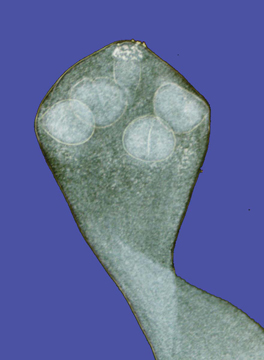Tapeworms
 Tapeworms are long, flat worms that attach themselves to your dog’s (or cat's) intestines. A tapeworm body consists of multiple parts, or segments, each with its own reproductive organs. Tapeworm infections are usually diagnosed by finding segments—which appear as small white worms that may look like grains of rice or seeds—on the rear end of your dog, in your dog’s feces, or where your dog lives and sleeps.
Tapeworms are long, flat worms that attach themselves to your dog’s (or cat's) intestines. A tapeworm body consists of multiple parts, or segments, each with its own reproductive organs. Tapeworm infections are usually diagnosed by finding segments—which appear as small white worms that may look like grains of rice or seeds—on the rear end of your dog, in your dog’s feces, or where your dog lives and sleeps.
There are several different kinds, or species, of tapeworms that can infect your dog, each with stage(s) in a different intermediate (in-between) host, which the dog eats to become infected. Dipylidium caninum is a tapeworm that uses fleas as its intermediate host, whereas Taenia and Echinococcus species use small rodents (mice, rats, squirrels), rabbits, or large animals (such as deer or sheep) as their intermediate hosts.
How will tapeworms affect my dog?
Dogs with tapeworm infections usually are not sick and do not lose weight from the worms. Contrary to popular belief, dogs that “scoot” on their rear ends are generally doing it for reasons other than having tapeworms, such as blocked or irritated anal sacs (pouches located in your dog’s rear end) or other skin inflammation of the rear.
How do I prevent my dog from getting tapeworms?
Try to keep your dog from coming in contact with intermediate hosts that contain tapeworm larvae. Because fleas are an intermediate host for the most common kind of tapeworm, consistent, safe, and effective flea control is an essential prevention measure.
If you think your dog is infected with tapeworms, call your veterinarian for an appointment to get an accurate diagnosis and safe, effective treatment options.
To prevent Taenia and Dipylidium tapeworm infections in dogs, administer a monthly heartworm preventive that contains a drug specific for tapeworm infections. For more information about human infections, please visit www.cdc.gov/parasites.
Can humans be harmed by tapeworms?
Certain tapeworms found in dogs or cats may cause serious disease in humans. Fortunately, these tapeworms (Echinococcus species) are uncommon in the United States and are readily treated by prescriptions available from your veterinarian. There are rare reports of Dipylidium (a common tapeworm in pets) infections in children, but these infections are not associated with significant disease.
Did you know?
- Most tapeworms do not produce obvious symptoms in dogs, other than worm segments on your dog's rear end or feces.
- Dogs can get tapeworms from fleas, mice, or other rodents.
- Flea control is an important step in protecting your dog from tapeworms.
- People rarely are affected by dog tapeworms.
- Other kinds of worms that dogs can get include heartworms, hookworms, roundworms, and whipworms.
- Overview
- Coccidia
- Ear Mites
- Fleas
- Giardia
- Heartworms
- Hookworms
- Mange
- Roundworms
- Scabies
- Tapeworms
- Ticks
- Whipworms
Ask Your Veterinarian
Dogs most frequently get tapeworms from fleas, so keeping your pet free of these is a big help. Keeping your dog from eating prey animals is also important. If you think your dog may have tapeworms, your veterinarian can test for them, and will have safe and effective treatment options.